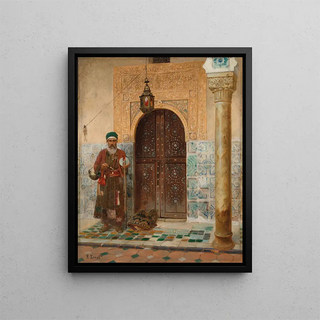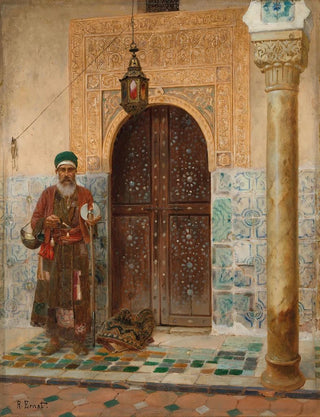Art print | A holy man near an entrance - Rudolf Ernst


View from behind

Frame (optional)
Art print of Saint Man Near an Entrance - Rudolf Ernst – Captivating Introduction
In the world of art, certain works transcend their era to capture the essence of a moment, a thought, or an emotion. "Saint Man Near an Entrance" by Rudolf Ernst is one of those creations that, through its depth and atmosphere, invites the viewer to introspective contemplation. This piece, imbued with spirituality, transports us to a universe where the sacred and the everyday meet, revealing the hidden beauty of simple moments. Observing this work, one feels an immediate connection with the central figure, whose presence seems both soothing and inspiring. The soft light enveloping the scene evokes a palpable serenity, prompting us to reflect on the nature of faith and spiritual quest.
Style and uniqueness of the work
Rudolf Ernst excels in depicting intimate scenes, where meticulous details and mastery of light combine to create a unique atmosphere. In "Saint Man Near an Entrance," the interplay of light and shadow highlights the textures of clothing and walls, giving the artwork an almost tactile dimension. The colors, both rich and delicate, invite exploration of the emotional nuances emanating from the painting. The composition, where the saint man is placed near an entrance, symbolizes the transition between the material world and the spiritual realm. This duality is reinforced by the skillful use of surrounding elements, which frame the figure while revealing a broader horizon, an invitation to discover the unknown.
The artist and his influence
Rudolf Ernst, an Austrian-born painter, established himself as a prominent figure in 19th-century Orientalist art. His fascination with Eastern cultures and his ability to depict them authentically made him a pioneer in this field. Influenced by travels and encounters, Ernst developed a style that combines realism and romanticism, creating works that tell stories while celebrating the beauty of landscapes and characters. His technique, blending precision and emotion, allowed him to capture moments of life with rare intensity. Thus, "Saint Man Near

Matte finish

View from behind

Frame (optional)
Art print of Saint Man Near an Entrance - Rudolf Ernst – Captivating Introduction
In the world of art, certain works transcend their era to capture the essence of a moment, a thought, or an emotion. "Saint Man Near an Entrance" by Rudolf Ernst is one of those creations that, through its depth and atmosphere, invites the viewer to introspective contemplation. This piece, imbued with spirituality, transports us to a universe where the sacred and the everyday meet, revealing the hidden beauty of simple moments. Observing this work, one feels an immediate connection with the central figure, whose presence seems both soothing and inspiring. The soft light enveloping the scene evokes a palpable serenity, prompting us to reflect on the nature of faith and spiritual quest.
Style and uniqueness of the work
Rudolf Ernst excels in depicting intimate scenes, where meticulous details and mastery of light combine to create a unique atmosphere. In "Saint Man Near an Entrance," the interplay of light and shadow highlights the textures of clothing and walls, giving the artwork an almost tactile dimension. The colors, both rich and delicate, invite exploration of the emotional nuances emanating from the painting. The composition, where the saint man is placed near an entrance, symbolizes the transition between the material world and the spiritual realm. This duality is reinforced by the skillful use of surrounding elements, which frame the figure while revealing a broader horizon, an invitation to discover the unknown.
The artist and his influence
Rudolf Ernst, an Austrian-born painter, established himself as a prominent figure in 19th-century Orientalist art. His fascination with Eastern cultures and his ability to depict them authentically made him a pioneer in this field. Influenced by travels and encounters, Ernst developed a style that combines realism and romanticism, creating works that tell stories while celebrating the beauty of landscapes and characters. His technique, blending precision and emotion, allowed him to capture moments of life with rare intensity. Thus, "Saint Man Near






